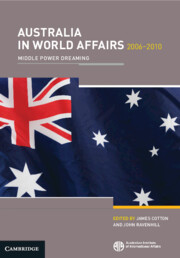Book contents
- Frontmatter
- Contents
- Tables, Figures and Boxes
- Contributors
- Preface
- Abbreviations
- 1 Middle Power Dreaming: Australian Foreign Policy during the Rudd–Gillard Governments
- 2 The Howard–Downer Legacy: Global Deputy, Regional Sheriff
- 3 Back from the Brink: Australia and the Global Economy 2006–10
- 4 Australia–America 2006–2010: Waiting for Obama
- 5 Australia and China: The Challenges to Forging a ‘True Friendship’
- 6 Australia and Japan: Mobilising the Bilateral Relationship
- 7 Australia and Europe
- 8 Australia’s Strategic and Commercial Engagement with South Asia under Kevin Rudd: The Paradoxes
- 9 Australia, the Pacific Islands and Timor-Leste
- 10 Progress and Limits in Regional Cooperation: Australia and Southeast Asia
- 11 Australian Foreign Policy towards Africa
- 12 Plus Ça Change? The Coalition, Labor and the Challenges of Environmental Foreign Policy
- 13 The Australia 2020 Summit as an Experiment in Foreign Policy-making
- 14 Defence and Security
- 15 Australia’s Foreign Policy Machinery
- 16 Regional, Alliance and Global Priorities of the Rudd–Gillard Governments
- References
- Index
13 - The Australia 2020 Summit as an Experiment in Foreign Policy-making
Published online by Cambridge University Press: 04 May 2024
- Frontmatter
- Contents
- Tables, Figures and Boxes
- Contributors
- Preface
- Abbreviations
- 1 Middle Power Dreaming: Australian Foreign Policy during the Rudd–Gillard Governments
- 2 The Howard–Downer Legacy: Global Deputy, Regional Sheriff
- 3 Back from the Brink: Australia and the Global Economy 2006–10
- 4 Australia–America 2006–2010: Waiting for Obama
- 5 Australia and China: The Challenges to Forging a ‘True Friendship’
- 6 Australia and Japan: Mobilising the Bilateral Relationship
- 7 Australia and Europe
- 8 Australia’s Strategic and Commercial Engagement with South Asia under Kevin Rudd: The Paradoxes
- 9 Australia, the Pacific Islands and Timor-Leste
- 10 Progress and Limits in Regional Cooperation: Australia and Southeast Asia
- 11 Australian Foreign Policy towards Africa
- 12 Plus Ça Change? The Coalition, Labor and the Challenges of Environmental Foreign Policy
- 13 The Australia 2020 Summit as an Experiment in Foreign Policy-making
- 14 Defence and Security
- 15 Australia’s Foreign Policy Machinery
- 16 Regional, Alliance and Global Priorities of the Rudd–Gillard Governments
- References
- Index
Summary
In March 2008, newly elected Prime Minister Kevin Rudd announced plans for a two-day national summit to be held in Canberra. The Australia 2020 Summit brought together 1000 of Australia’s ‘best and brightest brains’ to develop long-term strategic policies for Australia. Of these participants, 100 were given the task of presenting a strategic vision and recommendations on ‘Australia’s future security and prosperity in a rapidly changing region and world’. The 2020 Summit seemed to be one of the defining images of Prime Minister Rudd’s term of office from 2007 to 2010. It certainly marked a new development in the formation of Australian foreign policy. The summit was supplemented by school summits, a Youth Summit, various community summits, regional town hall forums and an open submission system that allowed all Australians directly to submit their policy ideas and recommendations. The inclusion of the broader public in a dialogue about Australia’s future role in the world was a notable departure from traditional foreign policy-making.
Keywords
- Type
- Chapter
- Information
- Australia in World Affairs 2006–2010Middle Power Dreaming, pp. 193 - 210Publisher: Cambridge University PressFirst published in: 2024

